Bayer R.G. Mechanical Wear Fundamentals and Testing, Revised and Expanded
Подождите немного. Документ загружается.

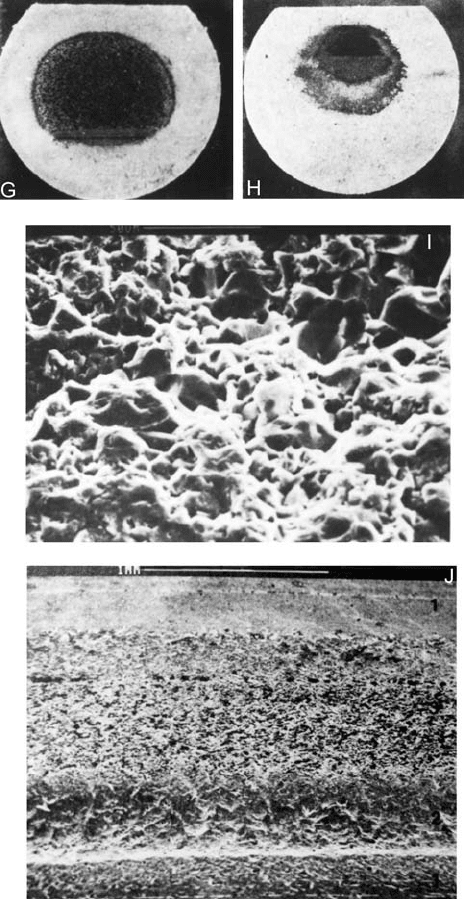
oxidative or chemical wear process discus sed in the section on wear mechanisms. In this
case, an oxide or other type of reacted layer is formed on the surface, as a result of the
wear. In general, the properties of the reacted layer will be different from those of the par-
ent material or any initial oxide. Another way in which the chemical make-up of the tri-
bosurface can be modified is conceptually illustrated in Fig. 4.21. Wear fragments from the
counterface, or wear fragments from the reacted layer, are worked into the surface, form-
ing a composite structure. An example of this type of phenomenon in the case of impact
wear is shown in Fig. 4.22. Similar observations have been made for sliding wear (32–34).
Figure 4.20 (continued )
Copyright 2004 by Marcel Dekker, Inc. All Rights Reserved.
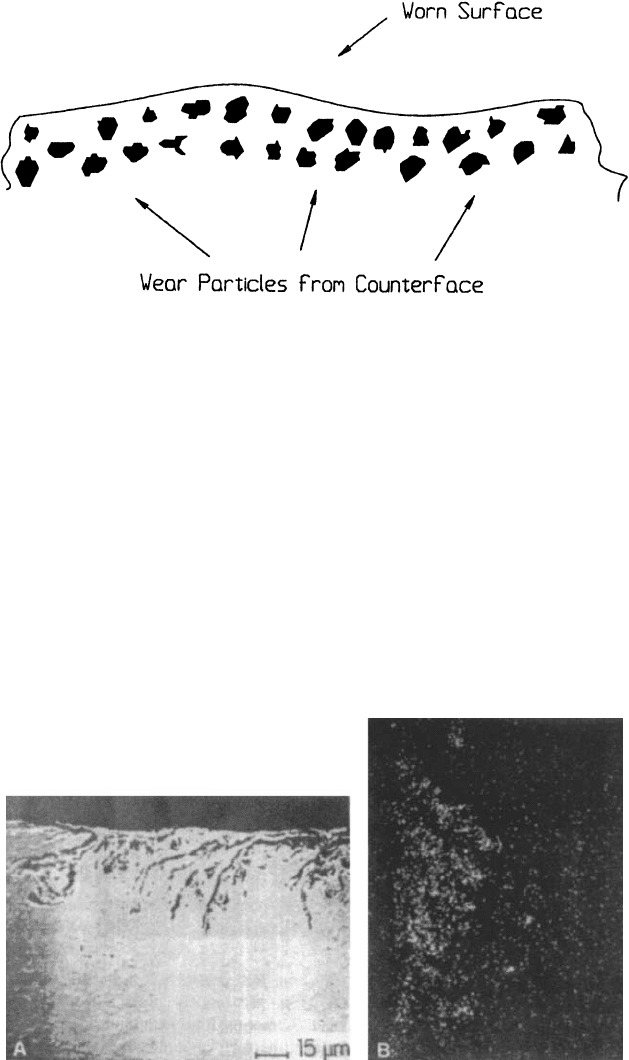
Structural changes can also take place as the result of the wearing action (e.g., plastic
deformation and flow). In the case of metals, changes in dislocation density and grain size
at or near the surface are frequently observed in wearing situations. Figure 4.23 shows
some examples of this behavior. Frequently, these changes result in a harder, more brittle
surface. When hardness changes as a result of wear, it is generally found that wear beha-
vior is related to the modified hardness. This is also true, when hardness is affected by fric-
tional heating, as described further in this section.
Another example is the formation of a layer composed of extremely fine grains and
flow-like striations found in some sliding wear situations (Fig. 4.24). As is apparent in this
figure, the morphology of this layer is very suggestive of fluid flow, and shows both
laminar and turbulent characteristics in different regions. Careful examination of the
Figure 4.22 Example of mechanical mixing under impact conditions between a steel sphere coated
with a thin layer of NI (5000 A) and a Cu flat. A cross-section through the wear scar in the Cu is
shown in ‘‘A’’. In ‘‘B’’, an EDX dot map of NI is shown for this region, confirming the mixing.
(From Ref. 92, reprinted with permission from Elsevier Sequoia S.A.)
Figure 4.21 Mechanically mixed surface layer.
Copyright 2004 by Marcel Dekker, Inc. All Rights Reserved.
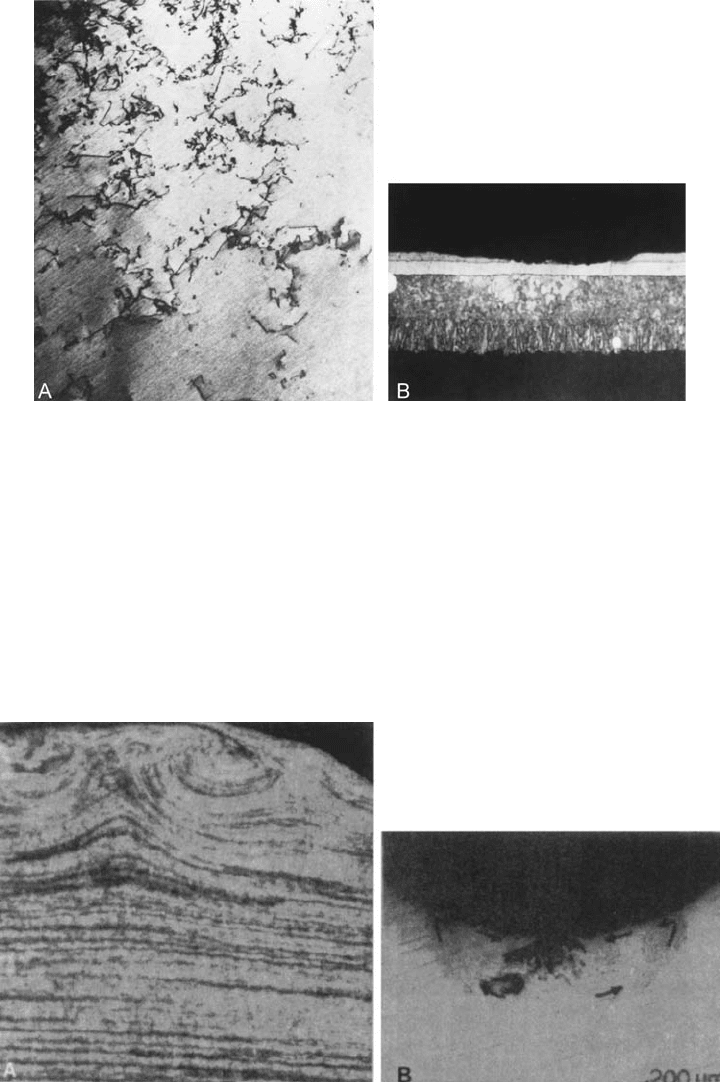
micrograph shows the formation of what appears to be an extrusion lip. Because of this lip
formation and the general characteristics of the layer, fine grains, and flow c haracteristics
(which are very similar to behavior seen in metal working operations), this mode of wear
has been referred to as extrusion wear (35).
Figure 4.23 Examples of the dislocation networks formed and grain size changes produced during
wear. ‘‘A’’ is the dislocation networks formed beneath the wear surface of a Cu specimen during ero-
sion. ‘‘B’’ shows the grain growth occurring in Cu in a small amplitude sliding wear situation. (‘‘A’’
from Ref. 93, reprinted with permission form ASTM; ‘‘B’’ from Ref. 94, reprinted with permission
from ASME.)
Figure 4.24 Example of subsurface flow during wear: ‘‘A’’ for sliding, ‘‘B’’ for impact. (‘‘A’’ from
Ref. 95, reprinted with permission from ASM International; ‘‘B’’ from Ref. 92, reprinted with per-
mission from Elsevier Sequoia S.A.)
Copyright 2004 by Marcel Dekker, Inc. All Rights Reserved.
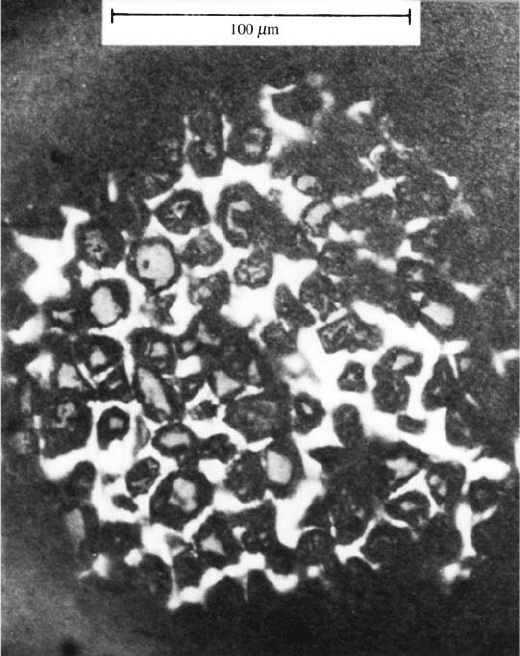
Preferential wearing of one phase of a multiphase material can also result in a change
in the composition of the surface and influence wear behavior. An example of this would
be the preferential removal of a so ft matrix around a hard filler, grain, or particle (36).
This situation is illustrated in Fig. 4.25. This type of action can also produce topological
or roughness changes. A further way by which surface composition can change is shown in
Fig. 4.26. This is by preferential diffusion of certain elements (37), either to the surface of a
material or into the surface of the mating material. Solubility and temperature are strong
factors in this type of mechanism. This is frequently a factor in wear situations involving
high temperatures, such as in machine tool wear.
Up to this point, metals have been used to illustrate composition an d structural
changes in tribosurfaces; however, such changes are not confined to this class of materials.
Similar changes can take place with other classes but they may be of different types, which
depend on the basic nature of the material. With polymers, for example, changes in both
the degree of crystallinity, chain length, and degree of cross-linking have been observed.
The formation of different polymer structures has also been observed to occur as a result
of wear (38–41).
Figure 4.25 Example of preferential wear of a soft matrix. This micrograph is of a coating, which
contained diamond particles in an Rh matrix, after it was worn by sliding against a paper surface
coated with magnetic ink. (From Ref. 36.)
Copyright 2004 by Marcel Dekker, Inc. All Rights Reserved.
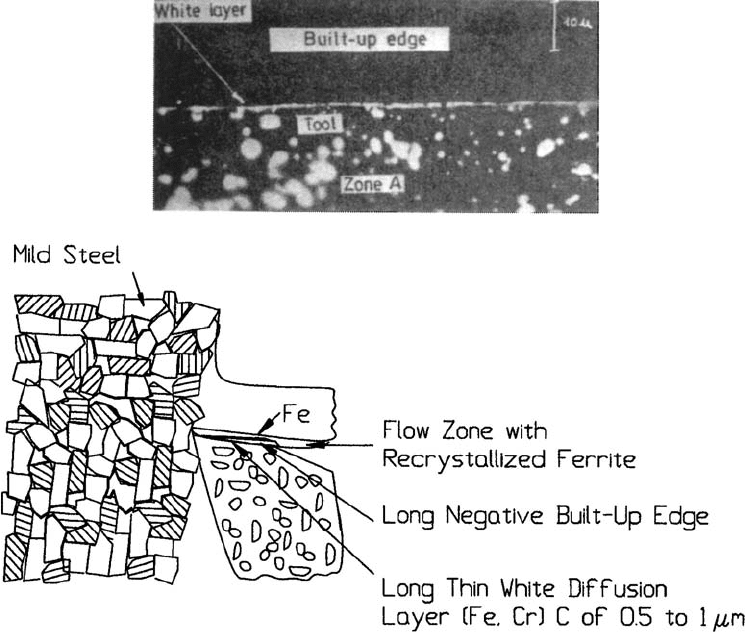
A factor that has to be included with the consideration of tribosurfaces is surface
temperature. In addition to leading to thermal wear mechanisms, discus sed in Sec. 3.6, sur-
face temperatures can affect wear behavior in other ways. As indicated in that section,
there are several factors which influence surface temperature, such as the heat energy gen-
erated at the surface, the thermal conductivities of the materials, heat conduction paths
away from the interfaces, and ambient temperature. This is illustrated in Fig. 4.27.
Because the heat or thermal energy is generated in the surfa ce (e.g., frictional heating in
sliding), surface temperatures are generally higher than elsewhere in the materials, which
can influence the nature of the surface in two ways. One is simply related to the fact that
most material properties are temperature dependent. As a result, the surface will exhibit
material behavior appropriate to that elevated temperature. For example, the hardness
of metals can decrease with surface temperature. This type of effect is particular ly impor-
tant in the case of polymer wear. With polymers degradation in wear performance is gen-
erally observed with the surface temperatur es approaching and exceeding the glass
transition temperature (23,42,43). A secon d way in which surface temperature can influ-
ence tribosurfaces is through the temperature dependencies that the surface modification
processes have. Elevated temperature can increase reaction rates, influence phase changes,
increase diffusion, and enhance flow characteristics of materials.
Figure 4.26 An example of a diffusion layer formed on a tool surface during machining. The dia-
gram shows the location of the diffusion layer on the tool surface. (From Ref. 96.)
Copyright 2004 by Marcel Dekker, Inc. All Rights Reserved.
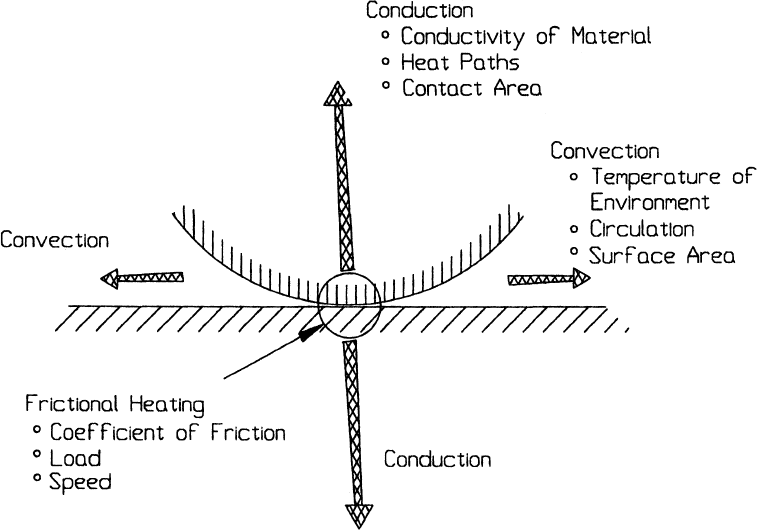
In addition to these possibilities, removal of existing layers and the formation of new
layers or films, such as, transfer and third-body films, can modify tribo surfaces, and
in turn affect wear behavior (7,16,24). Typically, a change in the coefficient friction
can be found with changes in oxide structure, removal of other films, and the form ation
of tribofilms (44). Removal of existing films and oxides is often a contributing factor
of break-in behavior (45). Many investigators have identified the formation of transfer
and third-body films and their importance in wear and friction behavior
(6,7,18,26,33,38,39,42, 46–49). The formation of these tribofilms and related wear pro-
cesses are described in Sec. 3.7.
While it is convenient for discussion to consider separately the various ways tribosur-
faces can unde rgo changes as a result of wear, it must be recognized that under actual
wearing conditions these changes can be going on simultaneously and in an interactive
fashion. For example, a flow layer might also contain a mixture of material from both sur-
faces, as well as oxides of these materials. An illustration of what typical conditions might
exist on worn surfaces is shown in Fig. 4.28.
4.4. WEAR TRANSITIONS
These changes to tribosurfaces, coupled with the possibility of different wear mechanisms,
can result in dramatic changes or transitions in wear behavior (44). The break-in pheno-
menon discussed previously is an example of such a transition. Break-in transitions tend
to be gradual and are usually attributed to the modification of the surfaces by such mecha-
nisms as oxide formation, transfer film formation, and asperity profile modification that
Figure 4.27 Factors affecting surface temperatures.
Copyright 2004 by Marcel Dekker, Inc. All Rights Reserved.
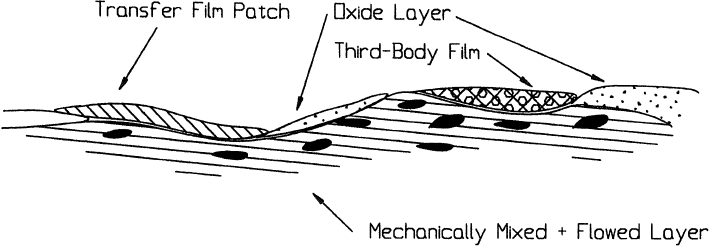
are associated with the wearing action. Transitions, which are associated with changes in
parameters, such as load, speed, relative humidity, or tempe rature, tend to be much more
abrupt and are frequently associated with a transition between mild and severe wear. In
either case, there can be changes in relative contributions and interactions of the several
possible wear mechanisms, along with changes in the characteristics of the wearing sur-
faces. To illustrate the general nature of such trans itions and the possible factors involved,
several examples will be considered.
During a break-in period, the wear rate is higher than after the break-in period. In
this sense, break-in behavior can be thought of as a transition from a severer to a milder
mode of wear. A wear curve, showing typic al break-in behavior, is presented in Fig. 4.29.
In this case, the wear is the wear of the plastic member of a cermet-plastic sliding wear
system. The micrographs in the figure show the appearance of the surfaces after the
break-in period. The break-in period in this case is associated with the formation of trans-
fer and third-body films on the surfaces. Break-in behavior is not limited to polymer–metal
sliding systems but occurs for other systems and in other situations. However, the mechan-
ism involved may be different. For example, the fretting wear behavior of a metallic sys-
tem is plotted in Fig. 4.30. A break-in period is evident and oxide film formations, along
with topological changes, are associated with this period. The appearance of the wear scar
in the break-in period and the stable period are different. These are shown in Fig. 4.31.
Another example for a metallic system is shown in Fig. 4.32. In this case, it is for a more
normal or gross sliding situation. However, the explanation is the same, oxide formation
with surface temperature being a driving factor. The insets show how the wear surface
appears in both regions.
In addition to the occurrence of break-in other transitions can occur as a function of
duration of the wearing actio n. An example of this is the behavior found in some four-ball
wear tests with lubricated metal pairs. This is shown in Fig. 4.33. In this particular case,
there appears to be several identifiable regions of wear behavior. The initial break-in pe r-
iod, a region of steady state wear, followed by a period of zero wear rate, ultimately leads to
a region of rapid or accelerated wear. The appearances of the worn surfaces in these
regions are different . The overall behavior is likely the result of a complex relationship
between film formation, topological modification, changing wear mechanisms, and lubri-
cant effects. A possible scenario is that oxide and other films form in the two initial peri-
ods, along with micro-smoothing of the topography, which leads to a period of very low
wear rate. Ultimately, however, fatigue wear roughens the surface and disrupts the bene-
ficial film, leading to accelerated wear.
Figure 4.28 Possible state of a surface modified by wear.
Copyright 2004 by Marcel Dekker, Inc. All Rights Reserved.
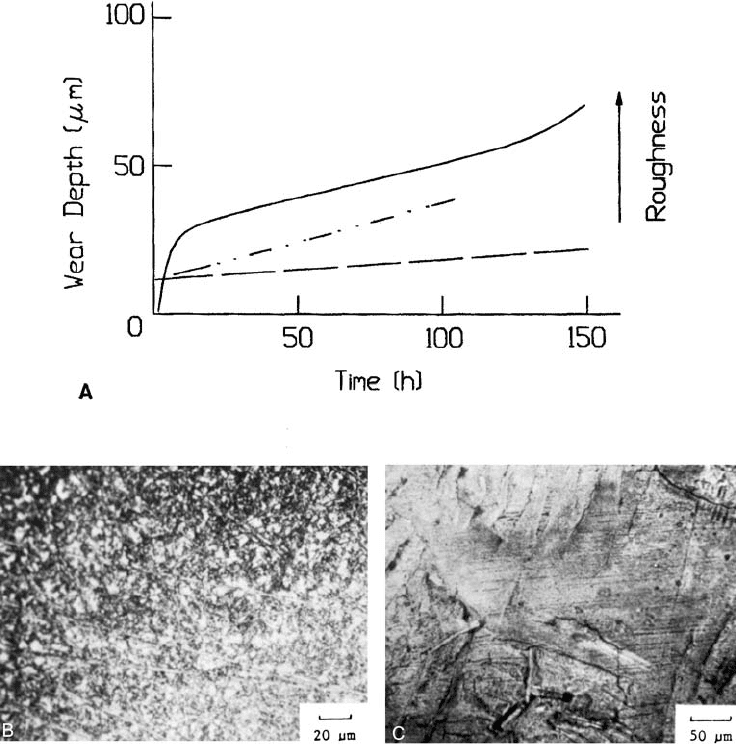
Another example of a transition in wear behavior is shown in Fig. 4.34. This is for
sliding wear of a metal–polymer system. In this case, an increase in wear rate is seen well
beyond the break-in period, and is associated with the disruption of the third-bod y film.
The data shown in the figure are for UHMWPE (ultra high molecular weight polyethy-
lene) and were obt ained in a thrust washer test. The same material, when tested in a
pin-on-disk configuration, showed similar behavior (i.e., the occurrence of a transition
well after break-in) (11,28). The reason for the increased wear was identified with the start
of fatigue wear, as evidence by micro-cracks in the surface. These delayed contributions
from fatigue wear are the result of the incubation period associated with this mechanism.
Another example of transitional behavior is the PV Limit generally associated with
the wear of polymers in metal–polymer and polymer–polymer sliding systems. In this case,
Figure 4.29 (‘‘A’’) Wear curves for the plastic in a plastic-cermet sliding situation. The curves are
for increasing roughness of the cermet. The mircrographs show the discontinuous transfer film on
the counterface (‘‘B’’) and the third-body film formed on the plastic (‘‘C’’) during break-in that
results in the reduction of wear rate. (From Ref. 7, reprinted with permission from ASME.)
Copyright 2004 by Marcel Dekker, Inc. All Rights Reserved.

the transition is between mild and severe wear behavior. Sliding conditions above the PV
Limit result in too high a temperature for the polymer, softening it to the extent that accel-
erated wear occurs. This behavior is illustrated in Fig. 4.35, which shows the PV Limit
curve for a polyimide and the correspondi ng relationship between wear rate and surface
Figure 4.30 Break-in behavior in the case of fretting between two metals. (From Ref. 24.)
Figure 4.31 Examples of wear scar morphologies for the system referenced in Fig. 4.30. ‘‘A’’ illus-
trates wear scar morphology prior to the formation of a stable and continuous oxide film. ‘‘B’’ illus-
trates the appearance after the formation of such a film. (From Ref. 24, reprinted with permission
from Elsevier Sequoia S.A.)
Copyright 2004 by Marcel Dekker, Inc. All Rights Reserved.
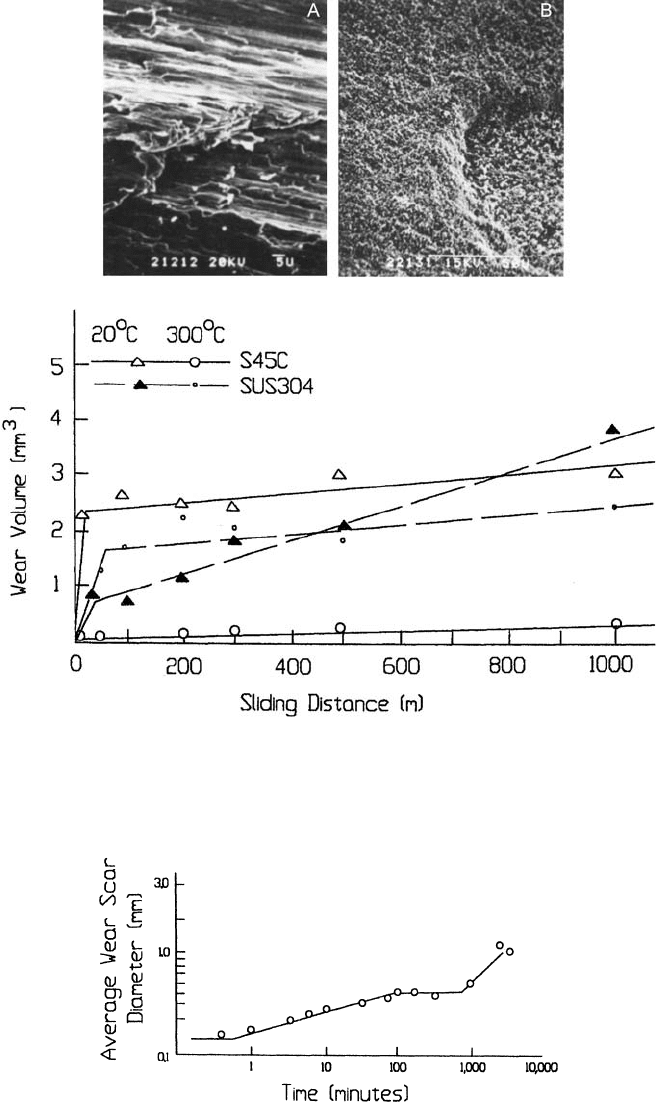
Figure 4.32 Example of break-in behavior as a result of oxide formation. Micrograph ‘‘A’’ shows
the appearance of the wear scar prior to the formation of the oxide layer, and ‘‘B’’ shows the appear-
ance after. (From Ref. 14, reprinted with permission from ASME.)
Figure 4.33 Time-dependent wear behavior of a lubricated metal couple in a four-ball wear test.
(From Ref. 19.)
Copyright 2004 by Marcel Dekker, Inc. All Rights Reserved.
